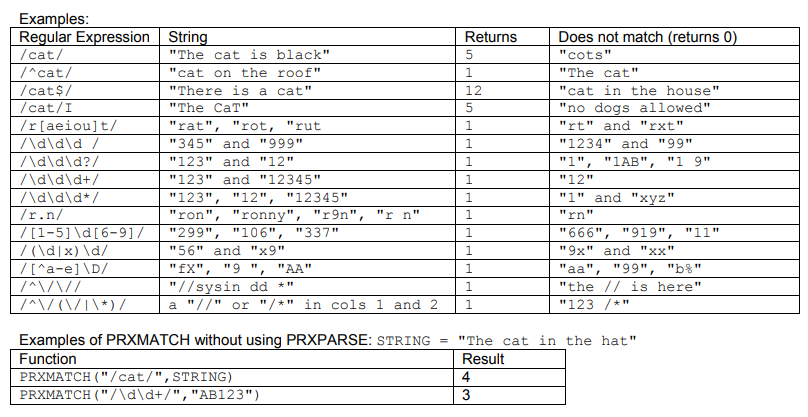SAS® Version 9.2 and Higher
SAS 9.2 On-Line: Informats, Formats, Functions, Functions by Category, Lists
| ANYALPHA() |
Returns first position of alphabetic character value. Note that special characters such as '< >' are not considered alphabetic characters and not identified with the ANYALPHA() function. May need to also apply SUBSTR(XXX, 1, 1) ^='<' for example. - if ANYALPHA()= 0 then only numeric values |
| ANYALNUM() |
Returns first position of numeric character value - if ANYALNUM()= 0 then only non-numeric values or alpha characters |
| ANYDTDTEW. |
Informat to read date values in any format - useful to read dates in mixed format as well as parital dates |
| CAT() |
Contenate multiple character variables back to back - v9func = CAT(a, b); |
| CATT() |
CAT() plus TRIM() each variable - v9func = CATT(a, b); |
| CATS() |
CAT() plus TRIM() and LEFT() each variable - v9func = CATS(a, b); |
| CATX() SAS Blog |
CAT() plus TRIM(), LEFT() and a separater delimiter between the variables - v9func = CATX(‘-’, a, b); |
| COMPARE() |
Compares two character variables, 0 if no difference |
| COUNT() |
Counts occurance of text within a character variable |
SYMPUTX() |
SYMPUT() plus TRIM(), LEFT() and PUT() with BEST12. format |

Beginner Paper Getting Familiar with SAS® Version 8.2 and 9.0 Enhancements, Sunil Gupta
SAS® Paper A Sampler of What's New in SAS 9.2
HOW Paper SAS 9 Programming Ennhancements, Marje Fecht
SAS Version 9 Highlights Presentation
SAS® Version 9.2 Don't Be a SAS Dinosaur: Modernizing Programs with Base SAS 9.2 Enhancements, Warren Repole - SAS Paper
Function & Call Routine Enhancements in SAS®9 Slides
SAS® Version 7 and 8 Paper What's New in Version 7 and 8 for SAS Files?

General Papers
1. New in SAS® 9.2: It’s the Little Things That Count, Diane Olson
2. This is the Modern World: Simple, Overlooked SAS® Enhancements, Bruce Gilsen
3. Using the New Features in PROC FORMAT, Rick Langston
4. Making the Most of Version 9 Features, Marje Fecht
5. A Survey of Some of the Most Useful SAS® Functions, Ron Cody
6. An Introduction to SAS® Hash Programming Techniques, Kirk Paul Lafler
7. SAS 9 Tips & Techniques, Philip Mason
8. Overview of Base SAS Changes in 9.1, Dana Rafiee
9. The Most Useful New Parts of SAS® 9, Phil Mason
10. Helpful Hints for Transitioning to SAS® 9.4, Cindy Taylor
11. Keeping Up With the FUN: New Functions in SAS 9, Deb Cassidy
12. What's in a SAS® Variable? Get Answers with a V!, William C. Murphy [VVALUE]
13. Let the CAT Out of the Bag: String Concatenation in SAS® 9, Joshua Horstman
14. Searching for Variable Values with CAT Functions: An Alternative to Arrays and Loops, Mike Zdeb
15. When ANY Function Will Just NOT Do, Richann Watson, Karl Miller
17. New Functions in SAS®9 – A Sampling, Keith Cranford
19. The Curious CAT (Q, S, T, X) Functions, Jinson Erinjer [CATX]
20. Let the CAT Out of the Bag: String Concatenation in SAS® 9, Joshua Horstman [CATX]
21. Purrfectly Fabulous Feline Functions, Louise Hadden [CATX]
22. The 5 CATs in the Hat – Sleek Concatenation String Functions, Kirk Paul Lafler

| SAS Technique |
Access Method / Lookup Technique (See also DATA Step/Merge, SAS Paper to compare) |
Temporary / Permanent |
Arrays and Do-Loops |
Sequential access, group related dataset or new variables or values to treat as single unit |
Temporary, convenience |
| SET with POINT= option with STOP statement |
Direct access by record number |
Temporary, effective |
| SAS Indexes |
Direct access by key variable value for more effective ascending sorting/merging and subsetting |
Permanent, up to 50% faster with PROC SORT if merging datasets, up to 100% slower without PROC SORT, may prevent other procedures such as PROC APPEND |
| Hash Tables |
Direct access by key variable value, reference datasets within DATA steps as a multiple dimensional array but with both numeric and character values |
Temporary, up to 10% faster than SAS index method |
Hash Tables (SAS 9: Hash Object Tip Sheet)
1. Data Step Hash Objects as Programming Tools, Paul M. Dorfman, Koen Vyverman
2. Introduction to SAS® Hash Objects, Chris Schacherer
3. Find() the power of Hash - How, Why and When to use the SAS® Hash Object, John Blackwell
4. The SAS Hash Object in Action, Paul Dorfman
5. Think FAST! Use Memory Tables (Hashing) for Faster Merging, Gregg Snell [Index, Behind the scences]
6. An Introduction to SAS® Hash Programming Techniques, Kirk Lafler
7. SAS® HASH Programming basics, Daniel Sakya
8. DATA Step Merging Techniques: From Basic to Innovative, Art Carpenter
9. E-Z Simple Hash Object Lookups, Andrew Dagis
11. Hashing Performance Time with Hash Tables, Elena Muriel
12. I cut my processing time by 90% using hash tables - You can do it too!, Jennifer Warner-Freeman [Business application]
13. Not Just Merge - Complex Derivation Made Easy by Hash Object, Lu Zhang
14. How Do You Use Look-up Tables?, Philip Holland [Presentation]
16. Matching Data Using Sounds-Like Operators and SAS Compare Functions, Amanda Roesch
17. Fuzzy Matching using the COMPGED Function Paulette Staum, Paulette Staum
2. Perl Regular Expressions in SAS® 9.1+ - Practical Applications, Joel Campbell
3. An Introduction to Regular Expressions with Examples from Clinical Data, Richard Pless
4. Taming Your Character Data with Regular Expressions in SAS® – Part I, Mary McCracken, James Campen
5. Performing Pattern Matching by Using Perl Regular Expressions, Arthur Li
